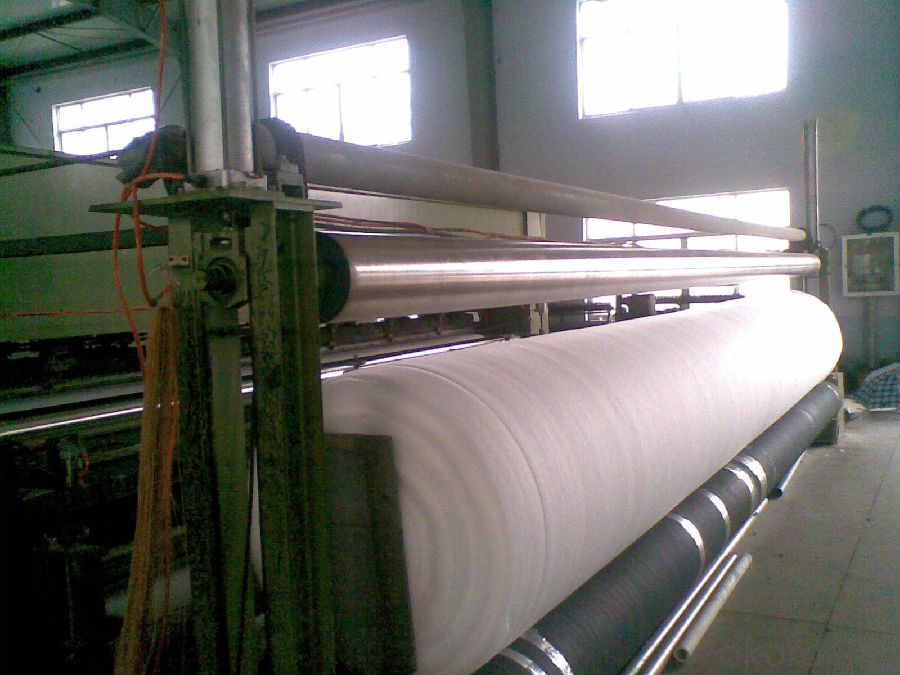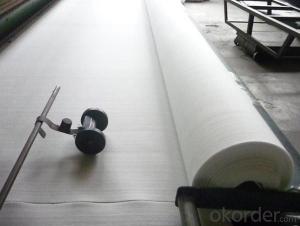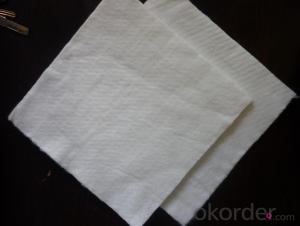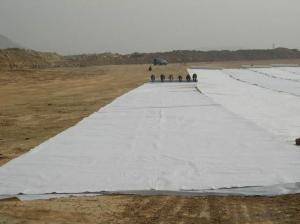Geotextile Fabric for Filtration and Protection
- Loading Port:
- Qingdao
- Payment Terms:
- TT OR LC
- Min Order Qty:
- 50000 m²
- Supply Capability:
- 5000000 m²/month
OKorder Service Pledge
OKorder Financial Service
You Might Also Like
Product Description:
1,Specification of PP/PET Nonwoven Geotextile Fabric
1)Area Weight: 100g/m2-1500g/m2
2) Width: Within 6 m (1m-6m)
3) Length: 50m-100m/roll (as per request)
4) Material: Polypropylene or polyester
2,Specialities of PP/PET Nonwoven Geotextile Fabric
1) Staple fibers needle punched nonwoven geotextile
The geotextile is made of polypropylene staple fibers on cross-laying equipment and needle punched equipment. It owns the advantages of acid and alkali resistance, erosion resistance, aging resistance, large strength, stable size, good filtrability etc.
3,Package of PP/PET Nonwoven Geotextile Fabric
Each roll is wrapped with plastic film. Or as per customer's request
4,Application of PP/PET Nonwoven Geotextile Fabric
1) Filtration :
The filtration layer of the dykes, river canal, seacoast, concrete slope, retaining walls. At the same time of preventing the clay granule from passing, it allows the water and the gas pass through freely.
2) Separation :
The isolation of the railway dregs and the roadbed, roadbed and the soft base, surface of the airdrome and parking lot and the groundsill, different dam materials. It isolates the soil and the gravel of two kinds different granule pathway from the groundsill or other buildings.
3) Adding muscle :
The highway, railway, soil-stone dam, breakwater, airport, backfill soil of retaining wall, slope protection, etc in which distributes the earth stress, prevents the side-displacement of the earth body and improves the earth body stability.
4) Protection :
It prevents the bank from being washed out, protects the bank and the bottom, prevents the water and soil from being washed away.



6.FAQ
We have organized several common questions for our clients,may help you sincerely:
1>How about your company?
A manufacturer & supplier focuses on the production of construction materials, including but not limited to PP staple fiber, geotextile geo-grid, geo-bag etc. Customized product is also available based on your detailed requirements.
2>How long can we receive the product after purchase?
It takes about 1 to 4 weeks to finish the production based on the specific production schedual. Then it will depend on the shipping time from loading port to the destination port.
- Q:Can geotextiles be used for reinforcement of railway embankments?
- Yes, geotextiles can be used for reinforcement of railway embankments. Geotextiles are commonly used in civil engineering projects for their ability to provide separation, filtration, and reinforcement functions. When used in railway embankments, geotextiles help improve the stability and strength of the embankment by preventing the mixing of different soil layers, reducing soil erosion, and distributing load more evenly. Overall, geotextiles are an effective solution for reinforcing railway embankments and enhancing their long-term performance.
- Q:Are geotextiles suitable for use in high-temperature environments?
- No, geotextiles are not suitable for use in high-temperature environments.
- Q:400g / m2 two cloth a layer of water permeable geotextile technical requirements
- Two cloth a film will not be permeable, the composite film index breaking strength 5kn top broken 1.1kn tear 0.15kn peel 6n / cm or substrate fracture without stripping, the current 2008 standard weight has not been required, the original standard For not less than 360 grams
- Q:Why do you want to add 1 to the amount of geotextile
- There are overlapping area and loss, I am specializing in the production of geotextiles
- Q:How do geotextiles affect soil erosion rates?
- Geotextiles can significantly reduce soil erosion rates by acting as a barrier against erosive forces such as water flow or wind. They provide stabilization and reinforcement to the soil, preventing it from being easily displaced or washed away. By enhancing the soil's resistance to erosion and promoting vegetation growth, geotextiles help maintain soil integrity and reduce erosion rates.
- Q:Stone cage slope is the first gravel or the first shop geotextile
- Hello, the first shop geotextile, put the cage on top, into the stone seal can be. We are Dongrun stone cage factory hope to help you.
- Q:Are geotextiles permeable to water?
- Yes, geotextiles are permeable to water.
- Q:What are the different types of geotextiles?
- There are several different types of geotextiles, including woven geotextiles, non-woven geotextiles, and knitted geotextiles. Woven geotextiles are made by weaving synthetic fibers together, creating a strong and durable material. Non-woven geotextiles are made by bonding or felting synthetic fibers together, providing filtration and drainage capabilities. Knitted geotextiles are produced by interlocking synthetic yarns, offering high tensile strength and flexibility. Each type of geotextile serves specific purposes in various applications, such as erosion control, soil stabilization, and drainage systems.
- Q:How do geotextiles contribute to soil filtration?
- Geotextiles contribute to soil filtration by acting as a barrier that allows water to pass through while retaining soil particles. They enhance the filtration process by preventing the migration of fine particles and protecting the underlying soil from erosion.
- Q:How do geotextiles help in reducing the risk of slope failures?
- Geotextiles help in reducing the risk of slope failures by providing reinforcement and stabilization to unstable slopes. These materials are placed within the slope to increase its strength and prevent erosion. Geotextiles also help in promoting water drainage and filtration, which reduces the build-up of hydrostatic pressure within the slope. Overall, geotextiles enhance the stability of slopes and mitigate the potential for landslides or slope failures.
1. Manufacturer Overview |
|
|---|---|
| Location | |
| Year Established | |
| Annual Output Value | |
| Main Markets | |
| Company Certifications | |
2. Manufacturer Certificates |
|
|---|---|
| a) Certification Name | |
| Range | |
| Reference | |
| Validity Period | |
3. Manufacturer Capability |
|
|---|---|
| a)Trade Capacity | |
| Nearest Port | |
| Export Percentage | |
| No.of Employees in Trade Department | |
| Language Spoken: | |
| b)Factory Information | |
| Factory Size: | |
| No. of Production Lines | |
| Contract Manufacturing | |
| Product Price Range | |
Send your message to us
Geotextile Fabric for Filtration and Protection
- Loading Port:
- Qingdao
- Payment Terms:
- TT OR LC
- Min Order Qty:
- 50000 m²
- Supply Capability:
- 5000000 m²/month
OKorder Service Pledge
OKorder Financial Service
Similar products
New products
Hot products
Hot Searches
Related keywords






























